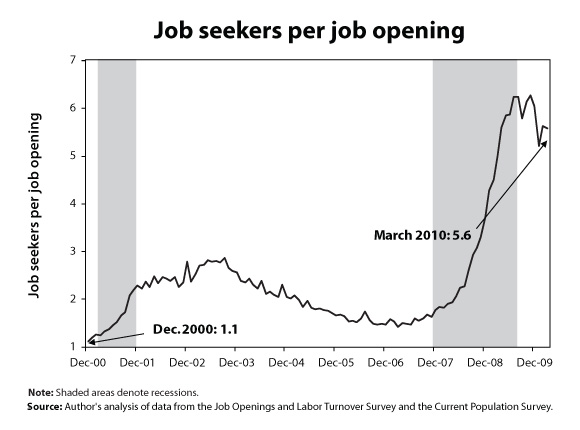This morning, the Bureau of Labor Statistics released the March report from the Job Openings and Labor Turnover Survey (JOLTS), showing that job openings increased by 47,000 to 2.7 million in March. However, this improvement was more than offset by a downward revision of 76,000 to the February data.
From the Current Population Survey, we know that the number of unemployed workers increased by 134,000 in March to 15.0 million. This means that in March, the ratio of unemployed workers to job openings was 5.6-to-one. This was unchanged from the revised February ratio but remains a significant improvement over the high of 6.2 job seekers per job opening last November. However, it is still far above where it needs to be to put this country’s unemployed workers back to work.

In December of 2000, the first date for which data are available, the ratio was 1.1-to-one. In other words, after the economic expansion of the 1990s, there was, on average, just over one job seeker per available job. Now, there are 5.6 unemployed workers per available job, and unsurprisingly, people who find themselves out of work are getting stuck in unemployment for extremely long periods. Current measures of long term unemployment are shattering records; For example, 45.9% of this country’s unemployed workers have been unemployed for over six months, the highest value of the current downturn and about 20 percentage points above the previous high of 26.0%, set in the summer of 1983.
Last Friday’s employment report showed hiring picking up in April, with the private sector adding 231,000 payroll jobs. However, the ranks of the unemployed also increased significantly, by 255,000. How can this happen? There is a large backlog of “missing workers’” that is, workers who dropped out of (or never entered) the labor force during the downturn, and they are now starting to return to the labor force in search of jobs. In April, the labor force increased by 805,000 workers. As workers continue entering or re-entering the labor force in search of work, the job-seekers-to-job-openings ratio will remain elevated, and the unemployed workers of this country will continue to have a very difficult time finding work.
For more information on how the current ratio of job seekers to job openings compares to past recessions, visit EPI’s Economy Track.
